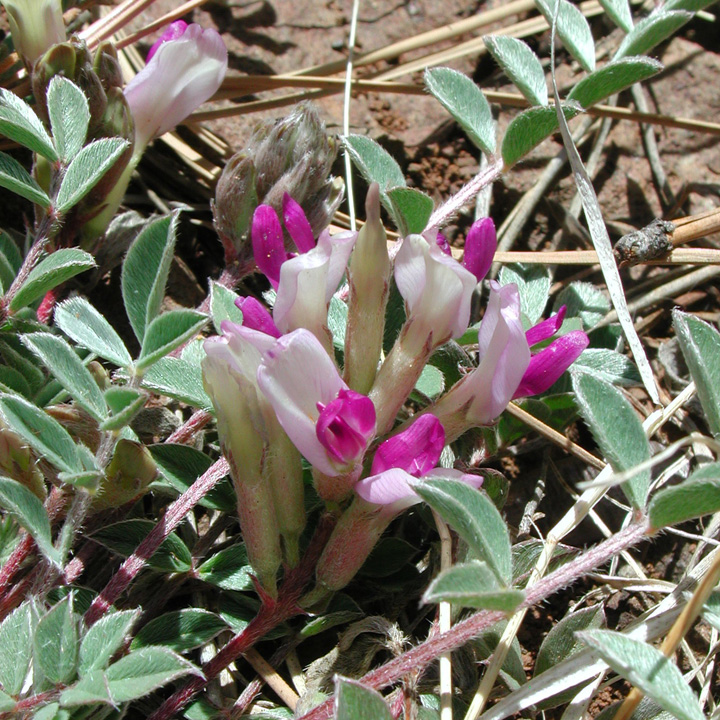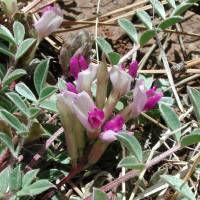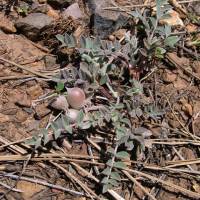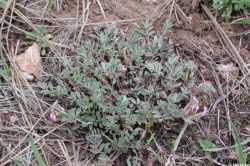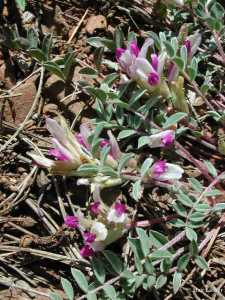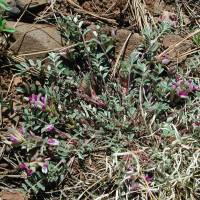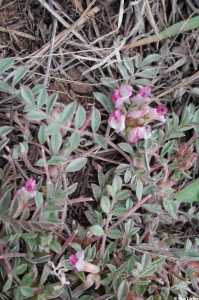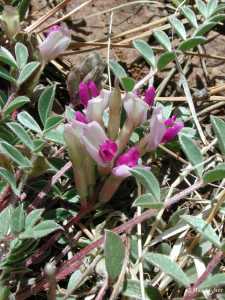General: Perennial, plants low or dwarf, densely tufted, acaulescent or nearly so, the stems, if present, up to 3 cm long, the internodes concealed by overlapping stipules; herbage gray or silvery, densely silky-strigose, the hairs dolabriform; root-crown many- headed or caudex shortly branched; taprooted.
Leaves: Alternate, odd-pinnate, 3-10 cm long; leaflets 7-13, obovate or elliptic-oblanceolate, 3-12 mm long, densely silky-strigose, margins entire, apex obtuse to nearly acute; stipules distinct, more-or-less clasping the stem; petiole slender, mostly as long as the rachis.
Flowers: Inflorescence of racemes, the lowest 1 (or 2) nodes of pistillate flowers, the remaining upper nodes all staminate; staminate flowers with 3-4 sepals, lanceolate, 1-2 mm long, widely spreading or reflexed at time of flowering, stamens 4-5; pistillate flowers with 5-7 sepals, 1.5-2.5 mm long, slender, leaf-like, reflexed in fruit; flowers March-November.
Fruits: Legume, ascending, lying on the ground, obliquely ovoid, lance-ovoid, or lance-ellipsoid, 1-2 cm long, 4-8 mm in diameter, somewhat curved and inflated, green to purplish, becoming straw colored or brownish, densely strigose; legumes sessile.
Ecology: Rocky habitats, pine forests; 1800-2400 m (6000-8000 ft); Coconino, Gila, Graham, Mohave, Navajo, and Yavapai counties; southwestern U.S.
Notes: Astragalus amphioxys (crescent milkvetch) is a winter annual or perennial, tufted to loosely matted, sub- acaulescent to shortly caulescent, the stems prostrate to weakly ascending, mostly 1-7 cm long; herbage is silvery- white, densely strigose with dolabriform hairs; leaves are 2-10 cm long, with mostly 11-21 leaflets, these elliptic, oblanceolate, or obovate, 3-13 mm long; raceme is mostly 4-10 flowered, the flowers bright pink-purple, the banner 11-28 mm long; legumes are ascending, lying on the ground, oblong to crescent-shaped, 2-5 cm long, strigose and usually strongly curved. It typically occurs on dry slopes, valley bottoms, and plains at 600-2300 m (2000-7500 ft). Astragalus calycosus (Torrey-s milkvetch) is tufted or matted, acaulescent, the stems rarely up to 2 cm long; herbage is gray-silvery and densely strigose with dolabriform hairs; leaves are 1-13 cm long, with 1- 13 leaflets, these obovate, oblanceolate, or elliptic, 2- 19 mm long; racemes are mostly 1-8 flowered, borne on leafless peduncles; flowers are whitish, pale blue, pink, or bright purple, the wing tips are always white or pale and keel tip spotted or blotched; banner is 9.5-16.5 mm long; wing petals are deeply notched at the apex; legumes are ascending, often lying on the ground, oblong- elliptic, linear-oblong, or lance-acuminate, 1-2 cm long, strigose, straight to somewhat curved. It primarily occurs on rocky slopes and mesas in pinyon-juniper and lower-elevation communities, but its distribution does extend into our elevational range. Chestnut milkvetch contains nitro-toxins.
Editor: Springer et al. 2008


